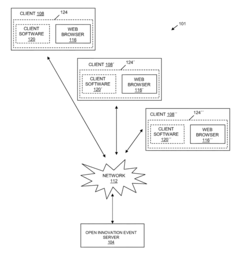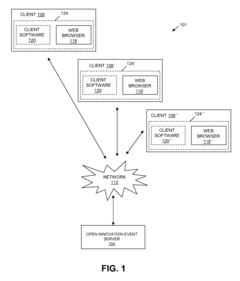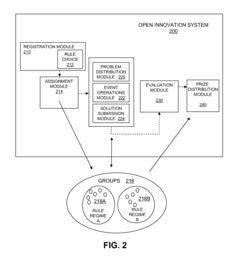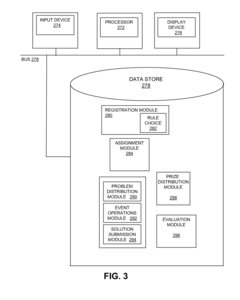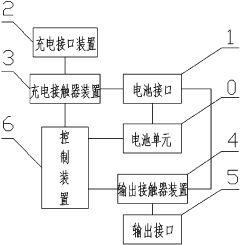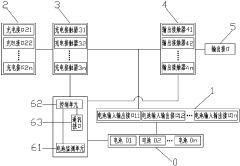Examining Open Innovation Models in Battery Management System Development
AUG 8, 20259 MIN READ
Generate Your Research Report Instantly with AI Agent
Patsnap Eureka helps you evaluate technical feasibility & market potential.
BMS Open Innovation Background and Objectives
Battery Management Systems (BMS) have become increasingly crucial in the rapidly evolving landscape of electric vehicles and renewable energy storage. The concept of open innovation in BMS development represents a paradigm shift from traditional closed R&D models, aiming to accelerate technological advancements and improve overall system performance.
The background of open innovation in BMS can be traced back to the early 2000s when the limitations of conventional closed innovation models became apparent in the face of growing complexity and interdisciplinary nature of BMS technology. As the demand for more efficient, reliable, and cost-effective energy storage solutions surged, companies realized the need for collaborative approaches to tackle the multifaceted challenges in BMS development.
Open innovation models in BMS development encompass various collaborative strategies, including partnerships between academia and industry, cross-sector alliances, and open-source initiatives. These approaches aim to leverage diverse expertise, share resources, and foster a more dynamic ecosystem for innovation.
The primary objectives of adopting open innovation models in BMS development are multifold. Firstly, it seeks to accelerate the pace of technological advancements by tapping into a broader pool of knowledge and expertise. This collaborative approach enables faster problem-solving and the integration of cutting-edge technologies from various domains.
Secondly, open innovation aims to reduce development costs and risks associated with BMS research. By sharing resources and distributing the burden of R&D across multiple stakeholders, companies can optimize their investment in innovation while minimizing potential financial risks.
Another key objective is to enhance the overall quality and performance of BMS solutions. Through collaborative efforts, developers can address complex challenges more effectively, leading to more robust and efficient systems. This is particularly crucial in the context of increasing demands for higher energy density, longer battery life, and improved safety features in energy storage applications.
Furthermore, open innovation models in BMS development strive to foster standardization and interoperability within the industry. By promoting shared platforms and open standards, these models aim to create a more cohesive ecosystem that facilitates seamless integration of various components and subsystems.
The evolution of open innovation in BMS also aligns with the broader trends in the tech industry, such as the rise of the Internet of Things (IoT) and the increasing emphasis on sustainability. These factors have further amplified the need for collaborative approaches in developing smart, connected, and environmentally friendly energy storage solutions.
As the BMS landscape continues to evolve, the objectives of open innovation extend beyond technological advancements to encompass broader societal goals. These include accelerating the transition to clean energy, promoting sustainable transportation, and addressing global challenges related to climate change and energy security.
The background of open innovation in BMS can be traced back to the early 2000s when the limitations of conventional closed innovation models became apparent in the face of growing complexity and interdisciplinary nature of BMS technology. As the demand for more efficient, reliable, and cost-effective energy storage solutions surged, companies realized the need for collaborative approaches to tackle the multifaceted challenges in BMS development.
Open innovation models in BMS development encompass various collaborative strategies, including partnerships between academia and industry, cross-sector alliances, and open-source initiatives. These approaches aim to leverage diverse expertise, share resources, and foster a more dynamic ecosystem for innovation.
The primary objectives of adopting open innovation models in BMS development are multifold. Firstly, it seeks to accelerate the pace of technological advancements by tapping into a broader pool of knowledge and expertise. This collaborative approach enables faster problem-solving and the integration of cutting-edge technologies from various domains.
Secondly, open innovation aims to reduce development costs and risks associated with BMS research. By sharing resources and distributing the burden of R&D across multiple stakeholders, companies can optimize their investment in innovation while minimizing potential financial risks.
Another key objective is to enhance the overall quality and performance of BMS solutions. Through collaborative efforts, developers can address complex challenges more effectively, leading to more robust and efficient systems. This is particularly crucial in the context of increasing demands for higher energy density, longer battery life, and improved safety features in energy storage applications.
Furthermore, open innovation models in BMS development strive to foster standardization and interoperability within the industry. By promoting shared platforms and open standards, these models aim to create a more cohesive ecosystem that facilitates seamless integration of various components and subsystems.
The evolution of open innovation in BMS also aligns with the broader trends in the tech industry, such as the rise of the Internet of Things (IoT) and the increasing emphasis on sustainability. These factors have further amplified the need for collaborative approaches in developing smart, connected, and environmentally friendly energy storage solutions.
As the BMS landscape continues to evolve, the objectives of open innovation extend beyond technological advancements to encompass broader societal goals. These include accelerating the transition to clean energy, promoting sustainable transportation, and addressing global challenges related to climate change and energy security.
Market Analysis for Open BMS Development
The open innovation model in Battery Management System (BMS) development is gaining significant traction in the market, driven by the rapid growth of the electric vehicle (EV) industry and the increasing demand for more efficient and reliable energy storage solutions. This approach to BMS development is reshaping the competitive landscape and creating new opportunities for collaboration across the value chain.
The global BMS market is experiencing robust growth, with projections indicating a compound annual growth rate (CAGR) of over 20% in the coming years. This growth is primarily fueled by the expanding EV market, which is expected to reach 145 million vehicles on the road by 2030, according to the International Energy Agency. The open innovation model is particularly well-suited to address the complex challenges in BMS development, as it allows for the integration of diverse expertise and technologies.
One of the key drivers for open BMS development is the need for standardization and interoperability. As the EV market matures, there is a growing demand for BMS solutions that can work seamlessly across different vehicle platforms and battery chemistries. This has led to increased collaboration between automakers, battery manufacturers, and technology providers, fostering an environment conducive to open innovation.
The market for open BMS solutions is also being propelled by the push for faster innovation cycles and reduced time-to-market. Traditional closed development models often struggle to keep pace with the rapidly evolving battery technologies and regulatory requirements. Open innovation allows companies to leverage external expertise and resources, accelerating the development process and enabling more agile responses to market demands.
Furthermore, the open BMS market is seeing increased interest from startups and small to medium-sized enterprises (SMEs). These agile players are often at the forefront of innovation, bringing fresh perspectives and cutting-edge technologies to the table. Their participation in open innovation ecosystems is creating a more dynamic and competitive market landscape, challenging established players to adapt and innovate.
The adoption of open BMS development is also being driven by the growing emphasis on sustainability and circular economy principles in the automotive and energy sectors. Open innovation models facilitate the development of more efficient and longer-lasting battery systems, contributing to reduced environmental impact and improved resource utilization throughout the battery lifecycle.
As the market for open BMS development continues to evolve, we are likely to see the emergence of new business models and revenue streams. This may include platform-based approaches, where companies provide open BMS frameworks that can be customized and extended by third-party developers, creating a vibrant ecosystem of specialized solutions and services.
The global BMS market is experiencing robust growth, with projections indicating a compound annual growth rate (CAGR) of over 20% in the coming years. This growth is primarily fueled by the expanding EV market, which is expected to reach 145 million vehicles on the road by 2030, according to the International Energy Agency. The open innovation model is particularly well-suited to address the complex challenges in BMS development, as it allows for the integration of diverse expertise and technologies.
One of the key drivers for open BMS development is the need for standardization and interoperability. As the EV market matures, there is a growing demand for BMS solutions that can work seamlessly across different vehicle platforms and battery chemistries. This has led to increased collaboration between automakers, battery manufacturers, and technology providers, fostering an environment conducive to open innovation.
The market for open BMS solutions is also being propelled by the push for faster innovation cycles and reduced time-to-market. Traditional closed development models often struggle to keep pace with the rapidly evolving battery technologies and regulatory requirements. Open innovation allows companies to leverage external expertise and resources, accelerating the development process and enabling more agile responses to market demands.
Furthermore, the open BMS market is seeing increased interest from startups and small to medium-sized enterprises (SMEs). These agile players are often at the forefront of innovation, bringing fresh perspectives and cutting-edge technologies to the table. Their participation in open innovation ecosystems is creating a more dynamic and competitive market landscape, challenging established players to adapt and innovate.
The adoption of open BMS development is also being driven by the growing emphasis on sustainability and circular economy principles in the automotive and energy sectors. Open innovation models facilitate the development of more efficient and longer-lasting battery systems, contributing to reduced environmental impact and improved resource utilization throughout the battery lifecycle.
As the market for open BMS development continues to evolve, we are likely to see the emergence of new business models and revenue streams. This may include platform-based approaches, where companies provide open BMS frameworks that can be customized and extended by third-party developers, creating a vibrant ecosystem of specialized solutions and services.
Current State and Challenges in BMS Open Innovation
The current state of open innovation in Battery Management System (BMS) development is characterized by a growing recognition of its potential to accelerate technological advancements and improve overall system performance. Many companies and research institutions are increasingly adopting collaborative approaches to tackle complex challenges in BMS design and implementation.
One of the primary drivers for open innovation in BMS is the rapid evolution of battery technologies and the need for more sophisticated management systems. As electric vehicles and renewable energy storage solutions become more prevalent, the demand for advanced BMS capabilities has intensified. This has led to a surge in collaborative efforts between automotive manufacturers, battery suppliers, and technology firms to develop more efficient and reliable BMS solutions.
However, the adoption of open innovation models in BMS development is not without its challenges. Intellectual property concerns remain a significant hurdle, as companies strive to balance knowledge sharing with protecting their competitive advantages. This has resulted in varying degrees of openness across different organizations, with some opting for more controlled collaborative environments while others embrace fully open platforms.
Another challenge lies in the standardization of BMS interfaces and protocols. The lack of universally accepted standards can hinder interoperability and limit the potential for widespread adoption of innovative solutions. Efforts are underway to address this issue, with industry consortia and standards bodies working towards establishing common frameworks for BMS development.
The complexity of BMS technology itself poses a challenge to open innovation initiatives. BMS encompasses a wide range of disciplines, including electrochemistry, power electronics, thermal management, and software engineering. Coordinating collaborative efforts across these diverse fields requires sophisticated project management and communication strategies.
Data sharing and privacy concerns also present obstacles to open innovation in BMS development. The sensitive nature of battery performance data and the potential for reverse engineering based on shared information have led some companies to be cautious about participating in open innovation platforms.
Despite these challenges, there are notable success stories in BMS open innovation. For instance, some automotive manufacturers have established open-source BMS projects, inviting contributions from the global developer community. These initiatives have led to improvements in algorithm efficiency, fault detection capabilities, and overall system robustness.
Looking ahead, the future of open innovation in BMS development appears promising, with increasing recognition of its potential to address complex technical challenges and accelerate the pace of innovation. As the industry continues to evolve, new models of collaboration are likely to emerge, potentially reshaping the competitive landscape and driving further advancements in battery management technology.
One of the primary drivers for open innovation in BMS is the rapid evolution of battery technologies and the need for more sophisticated management systems. As electric vehicles and renewable energy storage solutions become more prevalent, the demand for advanced BMS capabilities has intensified. This has led to a surge in collaborative efforts between automotive manufacturers, battery suppliers, and technology firms to develop more efficient and reliable BMS solutions.
However, the adoption of open innovation models in BMS development is not without its challenges. Intellectual property concerns remain a significant hurdle, as companies strive to balance knowledge sharing with protecting their competitive advantages. This has resulted in varying degrees of openness across different organizations, with some opting for more controlled collaborative environments while others embrace fully open platforms.
Another challenge lies in the standardization of BMS interfaces and protocols. The lack of universally accepted standards can hinder interoperability and limit the potential for widespread adoption of innovative solutions. Efforts are underway to address this issue, with industry consortia and standards bodies working towards establishing common frameworks for BMS development.
The complexity of BMS technology itself poses a challenge to open innovation initiatives. BMS encompasses a wide range of disciplines, including electrochemistry, power electronics, thermal management, and software engineering. Coordinating collaborative efforts across these diverse fields requires sophisticated project management and communication strategies.
Data sharing and privacy concerns also present obstacles to open innovation in BMS development. The sensitive nature of battery performance data and the potential for reverse engineering based on shared information have led some companies to be cautious about participating in open innovation platforms.
Despite these challenges, there are notable success stories in BMS open innovation. For instance, some automotive manufacturers have established open-source BMS projects, inviting contributions from the global developer community. These initiatives have led to improvements in algorithm efficiency, fault detection capabilities, and overall system robustness.
Looking ahead, the future of open innovation in BMS development appears promising, with increasing recognition of its potential to address complex technical challenges and accelerate the pace of innovation. As the industry continues to evolve, new models of collaboration are likely to emerge, potentially reshaping the competitive landscape and driving further advancements in battery management technology.
Existing Open Innovation Approaches in BMS
01 Battery monitoring and control
Battery management systems incorporate advanced monitoring and control mechanisms to optimize battery performance and longevity. These systems continuously track various parameters such as voltage, current, temperature, and state of charge to ensure safe and efficient operation. They also implement control algorithms to balance cell voltages, manage charging and discharging processes, and protect against overcharging or over-discharging.- Battery monitoring and control: Battery management systems incorporate advanced monitoring and control features to optimize battery performance and lifespan. These systems continuously track battery parameters such as voltage, current, temperature, and state of charge. They use this data to implement intelligent charging algorithms, balance cell voltages, and protect against overcharging or deep discharging.
- Thermal management: Effective thermal management is crucial for battery safety and longevity. Battery management systems employ various cooling and heating strategies to maintain optimal operating temperatures. This may include active cooling systems, passive heat dissipation methods, or intelligent temperature control algorithms to prevent overheating and ensure consistent performance across different environmental conditions.
- State estimation and prediction: Advanced battery management systems utilize sophisticated algorithms to estimate and predict battery state parameters. These include state of charge (SoC), state of health (SoH), and remaining useful life (RUL) estimations. By leveraging machine learning and data analytics, these systems can provide accurate predictions of battery performance and degradation, enabling proactive maintenance and optimized usage strategies.
- Communication and integration: Modern battery management systems feature robust communication capabilities to integrate with other vehicle systems or energy management platforms. They often support standard protocols for data exchange, enabling seamless integration with charging infrastructure, energy management systems, and diagnostic tools. This connectivity allows for remote monitoring, over-the-air updates, and advanced diagnostics.
- Safety and fault detection: Safety is a paramount concern in battery management systems. These systems incorporate multiple layers of protection, including hardware-based safety circuits and software-based fault detection algorithms. They can detect and respond to various fault conditions such as short circuits, overcharging, or abnormal temperature increases. Advanced systems may also include predictive fault detection capabilities to anticipate and prevent potential issues before they occur.
02 Thermal management in battery systems
Effective thermal management is crucial for battery performance and safety. Battery management systems employ various techniques to regulate battery temperature, including active cooling systems, passive heat dissipation methods, and intelligent temperature monitoring. These systems help prevent overheating, maintain optimal operating temperatures, and extend battery life by minimizing thermal stress on cells.Expand Specific Solutions03 State estimation and predictive analytics
Advanced battery management systems utilize sophisticated algorithms for accurate state estimation and predictive analytics. These systems employ machine learning and data analysis techniques to estimate battery state of charge, state of health, and remaining useful life. By analyzing historical data and current operating conditions, they can predict future battery performance and provide insights for maintenance and replacement planning.Expand Specific Solutions04 Communication and integration with vehicle systems
Modern battery management systems are designed to seamlessly integrate with other vehicle systems and communicate critical information. They interface with the vehicle's powertrain control, energy management, and diagnostics systems to optimize overall performance. These systems also support remote monitoring and over-the-air updates, enabling real-time data access and system improvements without physical intervention.Expand Specific Solutions05 Safety and fault detection mechanisms
Battery management systems incorporate robust safety features and fault detection mechanisms to ensure reliable and secure operation. These include continuous monitoring for abnormal conditions, implementation of safety protocols for various fault scenarios, and rapid response mechanisms to isolate faulty cells or modules. Advanced systems also employ predictive fault detection algorithms to identify potential issues before they escalate into critical problems.Expand Specific Solutions
Key Players in Open BMS Innovation
The development of open innovation models in Battery Management Systems (BMS) is currently in a growth phase, with increasing market size and technological advancements. The global BMS market is expanding rapidly, driven by the rising demand for electric vehicles and energy storage solutions. Technologically, the field is progressing from traditional closed systems to more collaborative, open-source approaches. Companies like Robert Bosch GmbH, LG Energy Solution, and Samsung SDI are leading the charge, leveraging their extensive R&D capabilities to develop advanced BMS solutions. Emerging players such as BattGenie and Breathe Battery Technologies are introducing innovative software-based approaches, indicating a shift towards more flexible and adaptable BMS architectures. This evolving landscape suggests a trend towards greater interoperability and standardization in BMS development.
Robert Bosch GmbH
Technical Solution: Bosch has developed an open innovation model for Battery Management System (BMS) development, focusing on collaborative partnerships and ecosystem integration. Their approach includes a modular BMS architecture that allows for easy integration of third-party components and algorithms[1]. Bosch's open innovation strategy involves partnerships with universities, startups, and other industry players to accelerate BMS development. They have implemented a cloud-based platform for real-time battery data analysis and predictive maintenance, which can be accessed and enhanced by partners[2]. Bosch also organizes hackathons and innovation challenges to crowdsource new ideas for BMS optimization[3].
Strengths: Extensive industry network, strong R&D capabilities, and established reputation in automotive electronics. Weaknesses: Potential challenges in managing intellectual property in open collaborations.
LG Energy Solution Ltd.
Technical Solution: LG Energy Solution has embraced open innovation in BMS development through its "Battery Innovation Contest" program, which invites external researchers and startups to contribute novel ideas[4]. Their open innovation model focuses on integrating artificial intelligence and machine learning algorithms into BMS for improved battery performance and longevity. LG has developed an open API framework that allows third-party developers to create applications and services that interact with their BMS[5]. They have also established joint research labs with universities to explore advanced BMS technologies, such as solid-state batteries and fast-charging solutions[6].
Strengths: Large-scale battery production capabilities, strong presence in the EV market. Weaknesses: Potential resistance to fully open-sourcing proprietary BMS technologies.
Core Technologies in Open BMS Development
System and method for conducting open innovation events
PatentActiveUS9652742B2
Innovation
- Implementing a system that allows participants to select from multiple rule regimes during event registration, with an assignment module grouping participants based on their chosen regime, enabling different rule regimes to apply to different groups, thereby allowing participants to work under preferred conditions.
Open battery power distribution management system
PatentActiveCN109649213A
Innovation
- An open battery power distribution management system is designed to achieve flexible adjustment of battery pack capacity and balanced energy release through portable batteries, charging contactor devices, output contactor devices and control devices, allowing one group of batteries to work while another group To charge the battery, use a small power generation device for charging.
Intellectual Property Strategies in Open BMS
In the context of open innovation models for Battery Management System (BMS) development, intellectual property (IP) strategies play a crucial role in balancing collaboration and protection. Companies engaging in open BMS development must carefully navigate the complex landscape of IP rights to foster innovation while safeguarding their competitive advantages.
One key strategy is selective disclosure, where companies strategically choose which aspects of their BMS technology to share openly and which to keep proprietary. This approach allows for collaboration on non-core components while maintaining control over critical innovations. For instance, a company might open-source basic BMS algorithms but retain exclusive rights to advanced predictive maintenance features.
Patent pooling is another effective strategy in open BMS development. By creating a shared repository of patents, multiple organizations can access and build upon each other's innovations without fear of infringement. This approach accelerates development cycles and reduces legal risks, particularly beneficial in the rapidly evolving field of battery management.
Cross-licensing agreements are also common in open BMS innovation models. These arrangements allow companies to exchange IP rights, enabling broader access to technologies while maintaining some level of exclusivity. Such agreements can be particularly valuable when different organizations possess complementary BMS technologies.
Open source licensing models, such as the Apache License or MIT License, provide a framework for companies to share their BMS software while retaining certain rights. These licenses allow for widespread adoption and improvement of the technology while ensuring proper attribution and, in some cases, requiring derivative works to be shared under similar terms.
Defensive publishing is another strategy employed in open BMS development. By publicly disclosing certain innovations without patenting them, companies can prevent others from obtaining exclusive rights to those ideas. This approach contributes to the collective knowledge base while strategically blocking potential patent threats.
Companies must also consider geographical IP strategies, as BMS regulations and market demands vary across regions. This may involve tailoring patent applications and licensing agreements to specific markets, ensuring global competitiveness while adapting to local requirements.
Lastly, establishing clear IP policies and governance structures within open innovation partnerships is essential. These frameworks define how IP will be managed, shared, and commercialized, reducing potential conflicts and fostering trust among collaborators in the BMS ecosystem.
One key strategy is selective disclosure, where companies strategically choose which aspects of their BMS technology to share openly and which to keep proprietary. This approach allows for collaboration on non-core components while maintaining control over critical innovations. For instance, a company might open-source basic BMS algorithms but retain exclusive rights to advanced predictive maintenance features.
Patent pooling is another effective strategy in open BMS development. By creating a shared repository of patents, multiple organizations can access and build upon each other's innovations without fear of infringement. This approach accelerates development cycles and reduces legal risks, particularly beneficial in the rapidly evolving field of battery management.
Cross-licensing agreements are also common in open BMS innovation models. These arrangements allow companies to exchange IP rights, enabling broader access to technologies while maintaining some level of exclusivity. Such agreements can be particularly valuable when different organizations possess complementary BMS technologies.
Open source licensing models, such as the Apache License or MIT License, provide a framework for companies to share their BMS software while retaining certain rights. These licenses allow for widespread adoption and improvement of the technology while ensuring proper attribution and, in some cases, requiring derivative works to be shared under similar terms.
Defensive publishing is another strategy employed in open BMS development. By publicly disclosing certain innovations without patenting them, companies can prevent others from obtaining exclusive rights to those ideas. This approach contributes to the collective knowledge base while strategically blocking potential patent threats.
Companies must also consider geographical IP strategies, as BMS regulations and market demands vary across regions. This may involve tailoring patent applications and licensing agreements to specific markets, ensuring global competitiveness while adapting to local requirements.
Lastly, establishing clear IP policies and governance structures within open innovation partnerships is essential. These frameworks define how IP will be managed, shared, and commercialized, reducing potential conflicts and fostering trust among collaborators in the BMS ecosystem.
Standardization Efforts in Open BMS Development
Standardization efforts in open Battery Management System (BMS) development have gained significant traction in recent years, driven by the need for interoperability, cost reduction, and accelerated innovation in the electric vehicle (EV) industry. These initiatives aim to create common frameworks, protocols, and interfaces that enable seamless integration of BMS components from various manufacturers.
One of the key players in this standardization effort is the Open BMS Initiative, a consortium of automotive manufacturers, battery suppliers, and technology companies. This group has been working on developing open-source BMS software and hardware designs that can be freely adopted and modified by industry participants. Their efforts have resulted in the creation of a standardized BMS architecture that defines common communication protocols, data formats, and functional modules.
The CAN (Controller Area Network) protocol has emerged as a widely adopted standard for BMS communication in EVs. The development of CAN-based BMS standards has facilitated easier integration of battery packs from different suppliers into various vehicle platforms. This standardization has significantly reduced development time and costs for automakers while improving overall system reliability.
Another important standardization effort is the development of the Smart Battery System (SBS) specification. This standard defines a common set of data and commands for battery communication, enabling interoperability between batteries, chargers, and host devices. The SBS specification has been particularly useful in promoting open innovation in portable electronics and is now being adapted for larger-scale applications in EVs.
The Open Charge Point Protocol (OCPP) is another standardization initiative that, while primarily focused on charging infrastructure, has implications for BMS development. By standardizing the communication between charging stations and central management systems, OCPP indirectly influences BMS design to ensure compatibility with various charging scenarios.
Efforts are also underway to standardize safety and performance testing procedures for BMS. Organizations such as SAE International and ISO are developing comprehensive test standards that cover various aspects of BMS functionality, including thermal management, cell balancing, and fault detection. These standards help ensure that open BMS designs meet rigorous safety and performance criteria across different implementations.
The push for standardization in open BMS development has not been without challenges. Balancing the need for a common framework with the desire for proprietary innovations has required careful negotiation among industry stakeholders. Additionally, ensuring backward compatibility with existing systems while advancing new standards has been a complex task that requires ongoing collaboration and compromise.
One of the key players in this standardization effort is the Open BMS Initiative, a consortium of automotive manufacturers, battery suppliers, and technology companies. This group has been working on developing open-source BMS software and hardware designs that can be freely adopted and modified by industry participants. Their efforts have resulted in the creation of a standardized BMS architecture that defines common communication protocols, data formats, and functional modules.
The CAN (Controller Area Network) protocol has emerged as a widely adopted standard for BMS communication in EVs. The development of CAN-based BMS standards has facilitated easier integration of battery packs from different suppliers into various vehicle platforms. This standardization has significantly reduced development time and costs for automakers while improving overall system reliability.
Another important standardization effort is the development of the Smart Battery System (SBS) specification. This standard defines a common set of data and commands for battery communication, enabling interoperability between batteries, chargers, and host devices. The SBS specification has been particularly useful in promoting open innovation in portable electronics and is now being adapted for larger-scale applications in EVs.
The Open Charge Point Protocol (OCPP) is another standardization initiative that, while primarily focused on charging infrastructure, has implications for BMS development. By standardizing the communication between charging stations and central management systems, OCPP indirectly influences BMS design to ensure compatibility with various charging scenarios.
Efforts are also underway to standardize safety and performance testing procedures for BMS. Organizations such as SAE International and ISO are developing comprehensive test standards that cover various aspects of BMS functionality, including thermal management, cell balancing, and fault detection. These standards help ensure that open BMS designs meet rigorous safety and performance criteria across different implementations.
The push for standardization in open BMS development has not been without challenges. Balancing the need for a common framework with the desire for proprietary innovations has required careful negotiation among industry stakeholders. Additionally, ensuring backward compatibility with existing systems while advancing new standards has been a complex task that requires ongoing collaboration and compromise.
Unlock deeper insights with Patsnap Eureka Quick Research — get a full tech report to explore trends and direct your research. Try now!
Generate Your Research Report Instantly with AI Agent
Supercharge your innovation with Patsnap Eureka AI Agent Platform!
